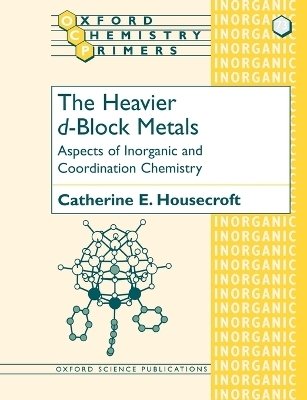
The Heavier d-Block Metals
Aspects of Inorganic and Coordination Chemistry
Seiten
1999
Oxford University Press (Verlag)
978-0-19-850103-9 (ISBN)
Oxford University Press (Verlag)
978-0-19-850103-9 (ISBN)
This book addresses the chemistry of the second and third row d-block metals, assuming a knowledge of the chemistry of the first row metals.
Chapter 1 looks at the metals and summarizes occurrence, physical properties and uses.
Chapter 2 considers periodic trends in properties.
Chapter 3 considers aqueous solution chemistry, species present (with comparisons of the first row metal ions) and redox properties.
Chapter 4 surveys structure: the range of coordination numbers shown by second and third row metals is often a topic for discussion in University courses.
Chapter 5 looks at electronic spectra and magnetic properties, making comparisons with the first row the main objective of the chapter. Detailed mathematical treatments are not given.
Chapter 6 considers metal-metal bonding, and the classes of compound that contain triple and quadruple bonds; the role of bridging ligands is introduced.
Chapter 7 looks at selected clusters with a pi donar ligands (e.g. metal halo species) in which metal-metal bonding is important.
Chapter 8 introduces the area of polyoxometallates, closing with a short discussion of the wide range of applications.
The book contains many references to encourage wider reading by the student; in addition to textbooks of relevance, the author has included many recent literature citations, and a section called "Metals in Action" which gives citations which show the heavier metals at work in, for example, catalytic converters and molecular wires.
Chapter 1 looks at the metals and summarizes occurrence, physical properties and uses.
Chapter 2 considers periodic trends in properties.
Chapter 3 considers aqueous solution chemistry, species present (with comparisons of the first row metal ions) and redox properties.
Chapter 4 surveys structure: the range of coordination numbers shown by second and third row metals is often a topic for discussion in University courses.
Chapter 5 looks at electronic spectra and magnetic properties, making comparisons with the first row the main objective of the chapter. Detailed mathematical treatments are not given.
Chapter 6 considers metal-metal bonding, and the classes of compound that contain triple and quadruple bonds; the role of bridging ligands is introduced.
Chapter 7 looks at selected clusters with a pi donar ligands (e.g. metal halo species) in which metal-metal bonding is important.
Chapter 8 introduces the area of polyoxometallates, closing with a short discussion of the wide range of applications.
The book contains many references to encourage wider reading by the student; in addition to textbooks of relevance, the author has included many recent literature citations, and a section called "Metals in Action" which gives citations which show the heavier metals at work in, for example, catalytic converters and molecular wires.
| Erscheint lt. Verlag | 4.2.1999 |
|---|---|
| Reihe/Serie | Oxford Chemistry Primers ; 73 |
| Zusatzinfo | numerous line figures |
| Verlagsort | Oxford |
| Sprache | englisch |
| Maße | 188 x 245 mm |
| Gewicht | 225 g |
| Themenwelt | Naturwissenschaften ► Chemie ► Anorganische Chemie |
| Naturwissenschaften ► Chemie ► Organische Chemie | |
| Technik | |
| ISBN-10 | 0-19-850103-X / 019850103X |
| ISBN-13 | 978-0-19-850103-9 / 9780198501039 |
| Zustand | Neuware |
| Haben Sie eine Frage zum Produkt? |
Mehr entdecken
aus dem Bereich
aus dem Bereich
Buch | Hardcover (2024)
Springer Spektrum (Verlag)
64,99 €


